
CBSE Worksheet for chapter-7 Lines and Angles class 9
Worksheet For class 9
Find CBSE Worksheet for chapter-7 Lines and Angles class 9
CLASS-9
BOARD: CBSE
Mathematic Worksheet - 7
TOPIC: Lines and Angles
This page is prepared by the Academic team of Physics Wallah which consists of CBSE Board Worksheet for Class 9 Maths . Students of Class 9 Maths can get a free Worksheet for Class 9 Maths in PDF format prepared as per the newest syllabus and examination pattern in your schools.
Before solving the Worksheet for Class 9 one must read the textbook of your school board exam and try to read the notes given in Physics Wallah Class 9 notes sections. Students can also download free pdf of Class 9 Maths Notes prepared by teachers and solve important problems provided here with solutions on daily basis to get more scores in school exams and tests. Physics Wallah worksheets for Class 9 CBSE can help students practice with tests and quickly revise lessons learned in the classroom with essential resources such as video lessons, short notes, and sample papers.
Class 9 Board is one of the most important year for every student and need a good planning and right study material to score good marks in your final exam. For other CBSE Worksheets for class 9 Mathematics check out the main page of Physics Wallah.
Summary
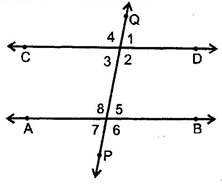
- Transversal: A line which intersects two or more given parallel lines at distinct points is called a transversal of the given lines.
- Corresponding angles: 1 & 5, 4 & 8, 2 & 6, 3 & 7 are pairs of corresponding angles.
- Alternate interior angles: 3 & 5, 2 & 8 are the pairs of alternate interior angles.
- Consecutive interior angles: 2 & 5, 3 & 8, are pairs of consecutive interior angles.
- Vertically opposite angles: in figure, 1 = 3, 2 = 4, 5 = 7 & 6 = 8.
Objective- 1
Q1. Two parallel lines have
- a common point
- two common points
- no common point
- infinite common points
Q2. An angle is 14 o more than its complementary angle then angle is
- 38 o
- 52 o
- 50 o
- None of these
Q3. X lies in the interior of BAC. If ∠BAC=70 o and ∠BAX=42 o , ∠CAX=
- 28 0
- 29 0
- 27 0
- 30 0
Q4. Two angles whose measure are a and b are such that 2a-3b=60 0 then =?, if they form a linear pair
- 0
- 8/5
- 1/2
- 2/3
Q5. Which one of the following is correct?
- If two parallel lines are intersected by a transversal, then alternate angles are equal.
- If two parallel lines are intersected by a transversal, then sum of the interior angles on the same side of transversal is 180 o
- If two parallel lines are intersected by a transversal, then corresponding angles are equal
- All of these.
Objective- 2
Q1. Two supplementary angles are in ratio 4 : 5, then the angles are:
- 80°, 100°
- 70°, 110°
- 80°, 120°
- None
Q2. If an angle differs from its complement by 10°, find the larger angle.
- 45°
- 50°
- 95°
- 60°
Q3. In the given figure, OP and OQ bisect BOC and AOC respectively, then POQ is.
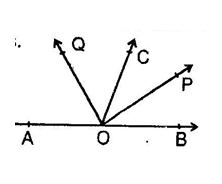
- 90°
- 45°
- 135°
- 180°
Q4. In the given fig if l II m, n II p and 1 = 85° then 2 is
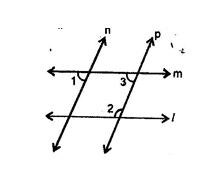
- 95°
- 110°
- 135°
- 85°
Q5. An larger angle is 14° more than its complementary angle then angle is:
- 38°
- 52°
- 50°
- none of these
Q6. X lies in interior of ∠BAC. If ∠BAC = 70° and ∠BAX = 42° then ∠XAC = ?
- 28°
- 29°
- 27°
- 30°
Q7. If the supplement of an angle is three times its complement, then angle is:
- 40°
- 35°
- 50°
- 45°
Q8. Two angles whose measures are a & b are such that 2a – 3b = 60°, if they form a linear pair then find .
- 0
- 8/5
- 1/2
- 2/3
Q9. The supplement of an angle is one third of itself. Then the angle is:
- 135°
- 45°
- 140°
- None
Q10. In given figure, if ∠BOC = 7x + 20° and ∠COA = 3x, then the value of x for which AOB becomes a straight line.
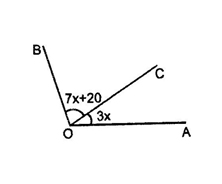
- 15°
- 12°
- 16°
- None
Q11. In given figure if AB II DF, AD II FG ∠BAC = 65°, ∠ACB=55 o ∠FGH is:
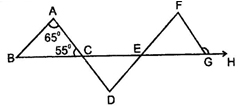
- 120°
- 125°
- 115°
- 140°
Q12. In given figure, AB II ED and ∠ABC = 30°, ∠EDC = 70° then x is:
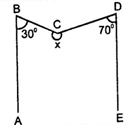
- 240°
- 125°
- 260°
- None
Q13. In the given figure, if EC II AB, ∠ECD = 70° and ∠BDO = 20°, then ∠OBD is-
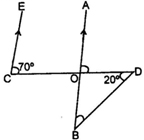
- 20°
- 50°
- 60°
- 70°
Q14. Given AB II CD, x° =
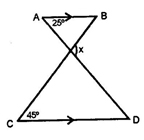
- 20°
- 70°
- 110°
- 35°
Q15. As shown in the figure
 . If point P is between these two lines such that m∠ABP = 50° and m∠CDP = 70° then find ∠BPD.
. If point P is between these two lines such that m∠ABP = 50° and m∠CDP = 70° then find ∠BPD.
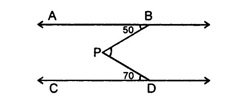
- 120°
- 70°
- 110°
- 50°
Q16. The measure of that angle which is four times its supplement is:
- 36
- 144°
- 155°
- 180°
Solutions
Objective-1
- 3
- 2
- 1
- 2
- 4
Objective-2
- 1
- 2
- 1
- 1
- 2
- 1
- 4
- 2
- 1
- 3
- 2
- 3
- 2
- 2
- 1
- 2









